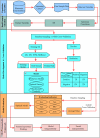Construction and SHAP interpretability analysis of a risk prediction model for feeding intolerance in preterm newborns based on machine learning
- PMID: 39558307
- PMCID: PMC11572196
- DOI: 10.1186/s12911-024-02751-5
Construction and SHAP interpretability analysis of a risk prediction model for feeding intolerance in preterm newborns based on machine learning
Abstract
Objective: To construct a highly accurate and interpretable feeding intolerance (FI) risk prediction model for preterm newborns based on machine learning (ML) to assist medical staff in clinical diagnosis.
Methods: In this study, a sample of 350 hospitalized preterm newborns were retrospectively analysed. First, dual feature selection was conducted to identify important feature variables for model construction. Second, ML models were constructed based on the logistic regression (LR), decision tree (DT), support vector machine (SVM) and eXtreme Gradient Boosting (XGBoost) algorithms, after which random sampling and tenfold cross-validation were separately used to evaluate and compare these models and identify the optimal model. Finally, we apply the SHapley Additive exPlanation (SHAP) interpretable framework to analyse the decision-making principles of the optimal model and expound upon the important factors affecting FI in preterm newborns and their modes of action.
Results: The accuracy of XGBoost was 87.62%, and the area under the curve (AUC) was 92.2%. After the application of tenfold cross-validation, the accuracy was 83.43%, and the AUC was 89.45%, which was significantly better than those of the other models. Analysis of the XGBoost model with the SHAP interpretable framework showed that a history of resuscitation, use of probiotics, milk opening time, interval between two stools and gestational age were the main factors affecting the occurrence of FI in preterm newborns, yielding importance scores of 0.632, 0.407, 0.313, 0.313, and 0.258, respectively. A history of resuscitation, first milk opening time ≥ 24 h and interval between stools ≥ 3 days were risk factors for FI, while the use of probiotics and gestational age ≥ 34 weeks were protective factors against FI in preterm newborns.
Conclusions: In practice, we should improve perinatal care and obstetrics with the aim of reducing the occurrence of hypoxia and preterm delivery. When feeding, early milk opening, the use of probiotics, the stimulation of defecation and other measures should be implemented with the aim of reducing the occurrence of FI.
Keywords: Feeding intolerance; Machine learning; Model construction; Preterm newborn.
© 2024. The Author(s).
Conflict of interest statement
Figures










Similar articles
-
Interpretable machine learning for allergic rhinitis prediction among preschool children in Urumqi, China.Sci Rep. 2024 Sep 27;14(1):22281. doi: 10.1038/s41598-024-73733-w. Sci Rep. 2024. PMID: 39333659 Free PMC article.
-
Establishment and validation of a heart failure risk prediction model for elderly patients after coronary rotational atherectomy based on machine learning.PeerJ. 2024 Jan 31;12:e16867. doi: 10.7717/peerj.16867. eCollection 2024. PeerJ. 2024. PMID: 38313005 Free PMC article. Clinical Trial.
-
Predictive model and risk analysis for peripheral vascular disease in type 2 diabetes mellitus patients using machine learning and shapley additive explanation.Front Endocrinol (Lausanne). 2024 Feb 28;15:1320335. doi: 10.3389/fendo.2024.1320335. eCollection 2024. Front Endocrinol (Lausanne). 2024. PMID: 38481447 Free PMC article.
-
Interpretable machine learning method to predict the risk of pre-diabetes using a national-wide cross-sectional data: evidence from CHNS.BMC Public Health. 2025 Mar 26;25(1):1145. doi: 10.1186/s12889-025-22419-7. BMC Public Health. 2025. PMID: 40140819 Free PMC article.
-
Prediction and feature selection of low birth weight using machine learning algorithms.J Health Popul Nutr. 2024 Oct 12;43(1):157. doi: 10.1186/s41043-024-00647-8. J Health Popul Nutr. 2024. PMID: 39396025 Free PMC article.
Cited by
-
Machine Learning-Driven Transcriptome Analysis of Keratoconus for Predictive Biomarker Identification.Biomedicines. 2025 Apr 24;13(5):1032. doi: 10.3390/biomedicines13051032. Biomedicines. 2025. PMID: 40426861 Free PMC article.
References
-
- Walani SR. Global burden of preterm birth[J]. Int J Gynaecol Obstet. 2020;150(1):31–3. - PubMed
-
- Minmin L, Zaixia S, Jin L, et al. Evidence summary for prevention and management of feeding intolerance in preterm infants[J]. Chin J Nurs. 2020;55(08):1163–8.
-
- Hegar B. Gastroesophageal reflux in infants[J]. Southeast Asian J Trop Med Public Health. 2014;45(Suppl 1):69–72. - PubMed
MeSH terms
LinkOut - more resources
Full Text Sources
Medical

